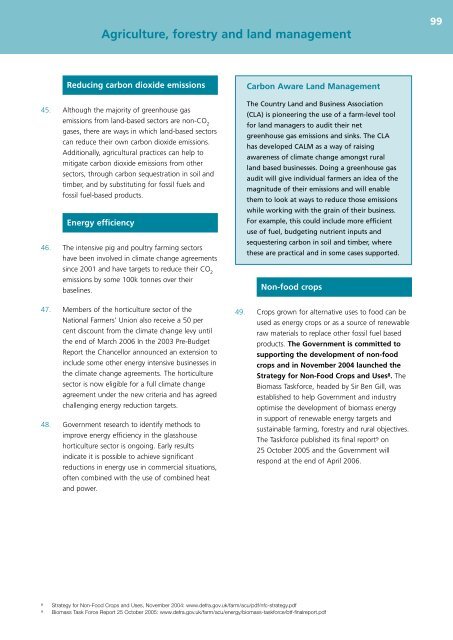UK Climate Change Programme 2006 - JNCC - Defra
UK Climate Change Programme 2006 - JNCC - Defra
UK Climate Change Programme 2006 - JNCC - Defra
Create successful ePaper yourself
Turn your PDF publications into a flip-book with our unique Google optimized e-Paper software.
Agriculture, forestry and land management<br />
99<br />
Reducing carbon dioxide emissions<br />
45. Although the majority of greenhouse gas<br />
emissions from land-based sectors are non-CO 2<br />
gases, there are ways in which land-based sectors<br />
can reduce their own carbon dioxide emissions.<br />
Additionally, agricultural practices can help to<br />
mitigate carbon dioxide emissions from other<br />
sectors, through carbon sequestration in soil and<br />
timber, and by substituting for fossil fuels and<br />
fossil fuel-based products.<br />
Energy efficiency<br />
46. The intensive pig and poultry farming sectors<br />
have been involved in climate change agreements<br />
since 2001 and have targets to reduce their CO 2<br />
emissions by some 100k tonnes over their<br />
baselines.<br />
Carbon Aware Land Management<br />
The Country Land and Business Association<br />
(CLA) is pioneering the use of a farm-level tool<br />
for land managers to audit their net<br />
greenhouse gas emissions and sinks. The CLA<br />
has developed CALM as a way of raising<br />
awareness of climate change amongst rural<br />
land based businesses. Doing a greenhouse gas<br />
audit will give individual farmers an idea of the<br />
magnitude of their emissions and will enable<br />
them to look at ways to reduce those emissions<br />
while working with the grain of their business.<br />
For example, this could include more efficient<br />
use of fuel, budgeting nutrient inputs and<br />
sequestering carbon in soil and timber, where<br />
these are practical and in some cases supported.<br />
Non-food crops<br />
47. Members of the horticulture sector of the<br />
National Farmers’ Union also receive a 50 per<br />
cent discount from the climate change levy until<br />
the end of March <strong>2006</strong> In the 2003 Pre-Budget<br />
Report the Chancellor announced an extension to<br />
include some other energy intensive businesses in<br />
the climate change agreements. The horticulture<br />
sector is now eligible for a full climate change<br />
agreement under the new criteria and has agreed<br />
challenging energy reduction targets.<br />
48. Government research to identify methods to<br />
improve energy efficiency in the glasshouse<br />
horticulture sector is ongoing. Early results<br />
indicate it is possible to achieve significant<br />
reductions in energy use in commercial situations,<br />
often combined with the use of combined heat<br />
and power.<br />
49. Crops grown for alternative uses to food can be<br />
used as energy crops or as a source of renewable<br />
raw materials to replace other fossil fuel based<br />
products. The Government is committed to<br />
supporting the development of non-food<br />
crops and in November 2004 launched the<br />
Strategy for Non-Food Crops and Uses 8 . The<br />
Biomass Taskforce, headed by Sir Ben Gill, was<br />
established to help Government and industry<br />
optimise the development of biomass energy<br />
in support of renewable energy targets and<br />
sustainable farming, forestry and rural objectives.<br />
The Taskforce published its final report 9 on<br />
25 October 2005 and the Government will<br />
respond at the end of April <strong>2006</strong>.<br />
8 Strategy for Non-Food Crops and Uses, November 2004: www.defra.gov.uk/farm/acu/pdf/nfc-strategy.pdf<br />
9 Biomass Task Force Report 25 October 2005: www.defra.gov.uk/farm/acu/energy/biomass-taskforce/btf-finalreport.pdf
















